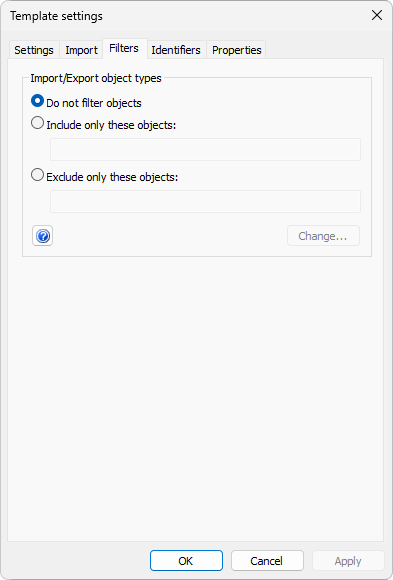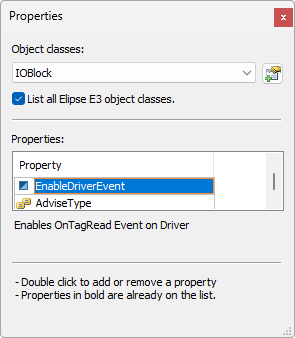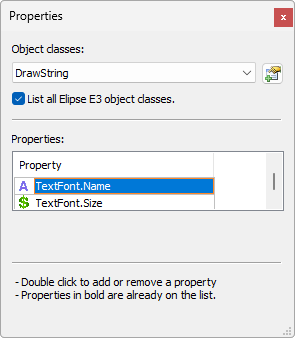The Template Settings is a tool that helps users to create an INI file to be used when importing or exporting Elipse E3 objects. To access it, click Import/Export and, once this option's window is opened, click Advanced. If users already loaded a template, values of initial options on these tabs reflect that configuration. The available tabs are described next.
•Settings: On this tab, users can configure valid options for the import process as well as for the export process

Settings tab
The available options on this tab are described on the next table.
Available options for Settings tab
Option |
Description |
|---|---|
Columns separator |
The available options are Use list separator configured in Windows: Selects the character configured on Windows as the list separator to use as CSV file's column separator or Use another character as separator: Lets users select another character as the column separator |
Other settings |
Defines what is imported or exported, objects, Links, or collections. The available options are Import/Export root object, Import/Export links, or Import/Export collections |
Save template |
When the Save changes from this template in an INI file option is selected, it defines an INI file where changes to this template are saved, and this file can then be used again. When this option is not selected, changes made to this template are temporarily saved to a file on Windows temporary folder. This file is used to perform an import or export process right after configuration, and it is removed later |
•Import: On this tab, users can configure import-only options

Import tab
The available options on this tab are described on the next table.
Available options for Import tab
Option |
Description |
|---|---|
Duplicated object import |
Specifies how Elipse E3 must handle the occurrence of duplicated objects during the import process. The available options are Ask me what to do in each case, Always overwrite existing object, Always ignore duplicated object, or Always create a new object |
Duplicated link import |
Specifies how Elipse E3 must handle the occurrence of duplicated Links during the import process. The available options are Ask me what to do in each case, Always overwrite existing Link, or Always ignore duplicated Link |
Duplicated collections import |
Specifies how Elipse E3 must handle the occurrence of duplicated collections during the import process. The available options are Ask me what to do in each case, Always overwrite existing collection, or Always ignore duplicated collection |
Duplicated collection items import |
Specifies how Elipse E3 must handle the occurrence of duplicated collection items during the import process. The available options are Ask me what to do in each case, Always overwrite existing item, Always ignore duplicated item, or Always create a new item |
•Filters: On this tab, users can select classes to use in the import or export process, or which classes not to use

Filters tab
The available options on this tab are described on the next table.
Available options for Filters tab
Option |
Description |
|---|---|
Do not filter objects |
Defines that all objects are imported or exported |
Include only these objects |
Defines which object classes are imported or exported |
Exclude only these objects |
Defines which object classes are not imported or exported |
Change |
Opens a window for selecting object classes to include or to exclude |
Help |
Opens a help window for this option |
By clicking Change, a window opens to select classes, as shown on the next figure.

Object classes
Classes that initially fill this list are the ones of the root and child objects, if a new template is being created. Users can also add other classes, by clicking Adds ![]() , or remove a class by clicking Removes
, or remove a class by clicking Removes ![]() .
.
•Identifiers: On this tab, users can define identifiers for the selected object classes. The initial status of this list is empty

Identifiers tab
The available options on this tab are described on the next table.
Available options for Identifiers tab
Option |
Description |
|---|---|
Class name |
Indicates the name of the selected class in this option |
Identifier |
Allows users to change the value to use on the ObjectType column of the CSV file. This column's initial value is always the object's class name. For each changed value here, an entry is generated on the INI file in Types section. These values are not case-sensitive, that is, "AAA", "aaa", and "aAa" are the same value. If users define the same value for more than one type, only the first type is considered during the import process, and an object may be created with a wrong type |
Adds |
Adds object classes |
Removes |
Removes the selected object class |
Help |
Displays a window with a help text |
•Properties: On this tab, users can select which object properties they want to use on the import or export process. This list's initial value is ObjectType and all other properties must be manually added

Properties tab
The available options on this tab are described on the next table.
Available options for Properties tab
Option |
Description |
|---|---|
Column name |
Allows users to change the value to use as a column's name on CSV file's header. This column's initial value is always the name of the property itself. For each changed value on this column, an entry is generated on the INI file in Columns section. Column names are not case-sensitive, that is, "AAA", "aaa", and "aAa" are the same value. If users define the same column's name for more than one property, only one of them is properly identified, and all columns with the same name point to the same property. In this case, some values may be overwritten |
Property |
Indicates the property being imported or exported |
Move to start |
Redefines column's sort order when changing property's sort order on the list |
Adds |
Adds properties to this list |
Removes |
Removes properties from this list, except for ObjectType. Alternatively, users can use the DELETE key to remove a property |
Group properties |
Creates a column's name linked to more than one property. Select the properties to group and then click this option. Column names are grouped on the same row, using the column's name defined for the property at the top of this list |
Help |
Displays a window with a help text |
By clicking Adds ![]() , a window opens to select properties, as shown on the next figure.
, a window opens to select properties, as shown on the next figure.

Properties window
The available options on this window are described on the next table.
Available options for Properties window
Option |
Description |
|---|---|
Object classes |
Displays object classes that match the selected filter starting at the root object |
Add all properties from |
Adds all properties from the selected object type in the previous option |
List all Elipse E3 object classes |
If selected, the object's combo box shows all existing classes in Elipse E3, regardless of a filter or root object |
Properties |
Displays properties of the selected object |
Properties displayed in bold on this list were already added to the list that defines columns on the CSV file. By double-clicking a property, users either add it or remove it from the list, depending on whether it was on the list or not. If a property was grouped with others, a double-click only removes this property from the group, keeping the other properties correctly grouped.
TextFont-type properties contain internal properties that configure certain font features, such as type and size. They are exported with the main property's name, according to the object, followed by the name of the internal property, separated by a period, such as in TextFont.Bold. In the template settings, internal properties are displayed separately, so that users can select them one by one.

TextFont-type properties